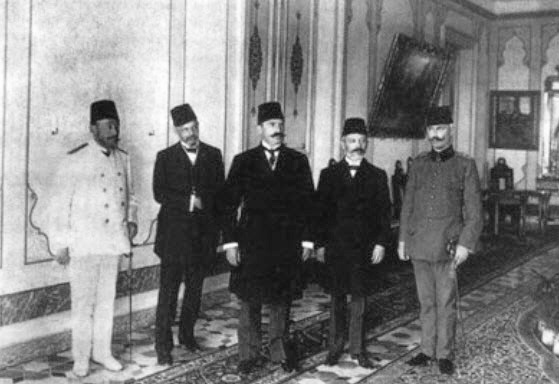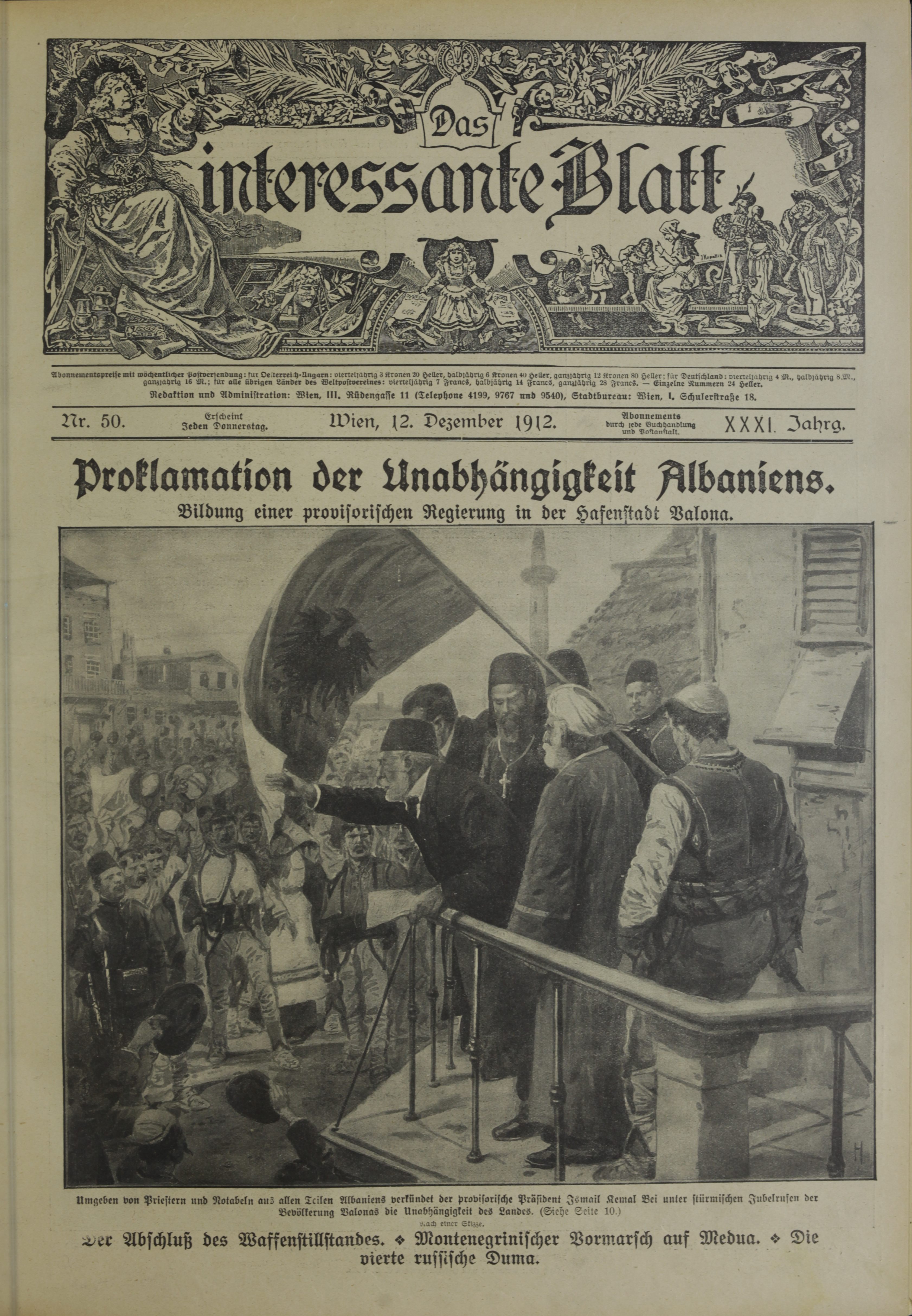|
Greçë Memorandum
The Greçë Memorandum ( sq, Memorandumi i Greçës) or the Red Book ( sq, Libri i Kuq) was a memorandum with twelve requests for the establishment of an autonomous Albanian province within the Ottoman Empire. The Memorandum was jointly written by Ismail Kemal bey Vlora and Luigj Gurakuqi. Requests The leaders of the Albanian Revolt of 1911 organized a meeting at the location of Greçë near Selcë village in Kelmend. Today, this location is a natural and cultural monument of Shkodër County listed as "Ahu i Gerçës". Ismail Qemali joined them and together they draw up the memorandum, sometimes referred to as the "Red Book" because of the color of its covers, which addressed their requests both to Ottoman Empire and Europe (in particular to the Great Britain). This memorandum was signed by 22 Albanian chieftains, four from each tribe of Hoti, Gruda and Shkreli, five from Kastrati, three from Kelmend and two from Shalë. Requests in the memorandum included: * General amnest ... [...More Info...] [...Related Items...] OR: [Wikipedia] [Google] [Baidu] |
Memorandum
A memorandum ( : memoranda; abbr: memo; from the Latin ''memorandum'', "(that) which is to be remembered") is a written message that is typically used in a professional setting. Commonly abbreviated "memo," these messages are usually brief and are designed to be easily and quickly understood. Memos can thus communicate important information efficiently in order to make dynamic and effective changes. In law, a memorandum is a record of the terms of a transaction or contract, such as a policy memo, memorandum of understanding, memorandum of agreement, or memorandum of association. In business, a memo is typically used by firms for internal communication, while letters are typically for external communication. Other memorandum formats include briefing notes, reports, letters, and binders. They may be considered grey literature. Memorandum formatting may vary by office or institution. For example, if the intended recipient is a cabinet minister or a senior executive, the form ... [...More Info...] [...Related Items...] OR: [Wikipedia] [Google] [Baidu] |
Ottoman Parliament
The General Assembly ( tr, Meclis-i Umumî (French romanization: "Medjliss Oumoumi" ) or ''Genel Parlamento''; french: Assemblée Générale) was the first attempt at representative democracy by the imperial government of the Ottoman Empire. Also known as the Ottoman Parliament (french: Parlement Ottoman'' Legislation ottomane'' Volume 5: https://upload.wikimedia.org/wikipedia/commons/6/67/L%C3%A9gislation_ottomane_ou_Recueil_des_Aristarchi-Bey_Gr%C3%A9goire_Tome5.pdf p. 295 (PDF p. 299/370)), it was located in Constantinople (Istanbul) and was composed of two houses: an upper house (Senate, ''Meclis-i Âyân''), and a lower house (Chamber of Deputies, ''Meclis-i Mebusân''). The General Assembly was first constituted on 23 December 1876 and initially lasted until 14 February 1878, when it was dissolved by Sultan Abdul Hamid II. As a result of the Young Turk Revolution which brought substantial reforms and larger participation by political parties, the General Assembly was re ... [...More Info...] [...Related Items...] OR: [Wikipedia] [Google] [Baidu] |
1911 In The Ottoman Empire
A notable ongoing event was the race for the South Pole. Events January * January 1 – A decade after federation, the Northern Territory and the Australian Capital Territory are added to the Commonwealth of Australia. * January 3 ** 1911 Kebin earthquake: An earthquake of 7.7 moment magnitude strikes near Almaty in Russian Turkestan, killing 450 or more people. ** Siege of Sidney Street in London: Two Latvian anarchists die, after a seven-hour siege against a combined police and military force. Home Secretary Winston Churchill arrives to oversee events. * January 5 – Egypt's Zamalek SC is founded as a general sports and Association football club by Belgian lawyer George Merzbach as Qasr El Nile Club. * January 14 – Roald Amundsen's South Pole expedition makes landfall, on the eastern edge of the Ross Ice Shelf. * January 18 – Eugene B. Ely lands on the deck of the USS ''Pennsylvania'' stationed in San Francisco harbor ... [...More Info...] [...Related Items...] OR: [Wikipedia] [Google] [Baidu] |
Albanians From The Ottoman Empire
The Albanians (; sq, Shqiptarët ) are an ethnic group and nation native to the Balkan Peninsula who share a common Albanian ancestry, culture, history and language. They primarily live in Albania, Kosovo, North Macedonia, Montenegro, Serbia as well as in Croatia, Greece, Italy and Turkey. They also constitute a large diaspora with several communities established across Europe, the Americas and Oceania. Albanians have Paleo-Balkanic origins. Exclusively attributing these origins to the Illyrians, Thracians or other Paleo-Balkan people is still a matter of debate among historians and ethnologists. The first certain reference to Albanians as an ethnic group comes from 11th century chronicler Michael Attaleiates who describes them as living in the theme of Dyrrhachium. The Shkumbin River roughly demarcates the Albanian language between Gheg and Tosk dialects. Christianity in Albania was under the jurisdiction of the Bishop of Rome until the 8th century AD. Then, dioceses ... [...More Info...] [...Related Items...] OR: [Wikipedia] [Google] [Baidu] |
Battle Of Deçiq
The Battle of Deçiq ( sq, Beteja e Deçiqit; Montenegrin: ) was a battle between Albanian tribesmen and Ottoman forces during the Malësori uprising of 1911. It was a turning point for Albania's secession from the Ottoman Empire. Dedë Gjo Luli, the organiser of the Albanian tribal forces, raised the Albanian flag for the first time since 1479 on the mountain of Deçiq after the Albanians had achieved victory over the Ottoman Turks. Location and Background The battle took place in Deçiq, south of the town of Tuzi (in modern-day Montenegro), within Gruda tribal territory. Tuzi is the town center of the Malësia region in Montenegro, whereas the town center of ''Malësia E Madhe'' is Koplik. Malësia is simply translated to "The Highlands", referring to the rough mountainous terrain that characterizes the region. Malësia has primarily Roman Catholic faith, although it has a sizeable Muslim population (including Koplik itself). The tribesman of Malësia is known as ''Malë ... [...More Info...] [...Related Items...] OR: [Wikipedia] [Google] [Baidu] |
Albanian Declaration Of Independence
The Albanian Declaration of Independence ( Albanian: ''Deklarata e Pavarësisë'') was the declaration of independence of Albania from the Ottoman Empire. Independent Albania was proclaimed in Vlorë on 28 November 1912. Six days later the Assembly of Vlorë formed the first Government of Albania which was led by Ismail Qemali and the Council of Elders (Pleqnia). The success of the Albanian Revolt of 1912 sent a strong signal to the neighboring countries that the Ottoman Empire was weak. The Kingdom of Serbia opposed the plan for an Albanian Vilayet, preferring a partition of the European territory of the Ottoman Empire among the four Balkan allies. Balkan allies planned the partition of the European territory of the Ottoman Empire among them and in the meantime the territory conquered during First Balkan War was agreed to have status of the Condominium. That was the reason for Ismail Qemali to organize an All-Albanian Congress in Vlorë. Independence Declaration The A ... [...More Info...] [...Related Items...] OR: [Wikipedia] [Google] [Baidu] |
Young Turk Revolution
The Young Turk Revolution (July 1908) was a constitutionalist revolution in the Ottoman Empire. The Committee of Union and Progress (CUP), an organization of the Young Turks movement, forced Sultan Abdul Hamid II to restore the Ottoman Constitution and recall the parliament, which ushered in multi-party politics within the Empire. From the Young Turk Revolution to the Empire's end marks the Second Constitutional Era of the Ottoman Empire's history. More than three decades earlier, in 1876, constitutional monarchy had been established under Abdul Hamid during a period of time known as the First Constitutional Era, which lasted for only two years before Abdul Hamid suspended it and restored autocratic powers to himself. The revolution began with CUP member Ahmed Niyazi's flight into the Albanian highlands. He was soon joined by İsmail Enver and Eyub Sabri. They networked with local Albanians and utilized their connections within the Salonica based Third Army to instigate a ... [...More Info...] [...Related Items...] OR: [Wikipedia] [Google] [Baidu] |
Kaza
A kaza (, , , plural: , , ; ota, قضا, script=Arab, (; meaning 'borough') * bg, околия (; meaning 'district'); also Кааза * el, υποδιοίκησις () or (, which means 'borough' or 'municipality'); also () * lad, kaza , group=note) is an administrative division historically used in the Ottoman Empire and is currently used in several of its successor states. The term is from Ottoman Turkish and means 'jurisdiction'; it is often translated 'district', 'sub-district' (though this also applies to a ), or 'juridical district'. Ottoman Empire In the Ottoman Empire, a kaza was originally a "geographical area subject to the legal and administrative jurisdiction of a '' kadı''. With the first Tanzimat reforms of 1839, the administrative duties of the ''kadı'' were transferred to a governor ''(kaymakam)'', with the ''kadıs'' acting as judges of Islamic law. In the Tanzimat era, the kaza became an administrative district with the 1864 Provincial Reform Law, whi ... [...More Info...] [...Related Items...] OR: [Wikipedia] [Google] [Baidu] |
Cepo
Cepo is a municipal administrative units, formerly known as communes in the Gjirokastër County, southern Albania. At the 2015 local government reform it became a subdivision of the municipality Gjirokastër. The municipal unit administrative center is Palokastër village and it consists on 10 other villages which are: Fushëbardhë, Zhulat, Taroninë, Mashkullorë, Çepun, Kodër, Plesat, Kardhiq, Prongji and Humelicë. History In 1185 the seat of the Orthodox bishopric of Dryinopolis was moved to Cepo until 1395 when it was transferred to Argyrokastron (modern Gjirokastër Gjirokastër (, sq-definite, Gjirokastra) is a city in the Republic of Albania and the seat of Gjirokastër County and Gjirokastër Municipality. It is located in a valley between the Gjerë mountains and the Drino, at 300 metres above sea le ...). In Medieval times, Zhulat was the home of Papa Zhuli, a Catholic priest who is credited for the ''Kanun'' of Laberia. Demographics The population at t ... [...More Info...] [...Related Items...] OR: [Wikipedia] [Google] [Baidu] |
Malësia
Malësia e Madhe ("Great Highlands"), known simply as Malësia ( sq, Malësia, cnr, / ), is a historical and ethnographic region in northern Albania and eastern central Montenegro corresponding to the highlands of the geographical subdivision of the Malësi e Madhe District in Albania and Tuzi Municipality in Montenegro. The largest settlement in the area is the town of Tuzi. Name ''Malësia e Madhe'' is Albanian for "great highlands". It is simply known as ''Malësia'', or in the local Gheg dialect, ''Malcía'' (). Elsie also describes the region as part of the Northern Albanian Alps. The tribes are commonly called "highlanders", sq, malësorët, malsort, anglicized as "Malissori" or "Malisors". An archaic term used by foreign travellers in the 1860s was "Malesians". Geography The region includes parts of the Accursed Mountains mountain range (known in Albanian as ) and hinterland of the Lake Scutari, with valleys of the Cem river. The Malësors (Albanian highlanders) l ... [...More Info...] [...Related Items...] OR: [Wikipedia] [Google] [Baidu] |




